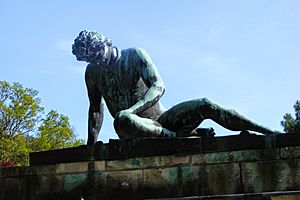Dying Gaul facts for kids
Quick facts for kids Dying Gaul |
|
|---|---|
| Italian: 'Galata Morente' | |
| Year | 230-220 BC |
| Medium | Marble |
| Dimensions | 93 cm × 186 cm × 89 cm (3 ft 1 in × 6 ft 1 in × 2 ft 11 in) |
| Location | Capitoline Museums, Rome |
The Dying Gaul is a famous ancient Roman statue made of marble. You can see it today in the Capitoline Museums in Rome, Italy. The statue shows a Celtic warrior from a region called Galatia who has been defeated in battle and is slowly dying.
This statue is actually a Roman copy of an even older Greek statue that was lost long ago. The original was probably made of bronze between 230 and 220 BC. It was created to celebrate a victory by King Attalus I of Pergamon over the Galatians, who were Celtic people living in an area of modern-day Turkey.
For a long time, people thought the statue showed a wounded fighter from a Roman amphitheater and called it The Dying Gladiator. But in the 1800s, experts realized it was a Gaulish warrior. They figured this out by looking at clues on the statue, like his spiky hair, mustache, and the special necklace called a torc.
Contents
A Closer Look at the Statue
The statue shows a Gaulish warrior in his final moments. He is slumped over his shield, struggling to support himself with one arm. The artist did an amazing job of showing the warrior's pain and bravery in his face. If you look closely, you can see a bleeding sword wound on the right side of his chest.
The warrior has features that were typical for Celts at the time. He has a thick, spiky hairstyle and a mustache but no beard. Around his neck is a torc, a metal ring that was a common piece of Celtic jewelry for important warriors.
Next to him on the ground are his weapons: a sword, a belt, and a curved trumpet called a carnyx. The handle of the sword is decorated with a lion's head. The marble base the statue rests on was added in the 1600s, after the statue was found.
How Was the Statue Found?
The Dying Gaul is believed to have been discovered in Rome in the early 1600s. It was found during the construction of a large house called the Villa Ludovisi. The statue was first listed as part of the Ludovisi family's art collection in 1623.
Later, in the 1730s, Pope Clement XII bought the statue for the Capitoline collections, where it has been for most of its time since.
However, the statue had a big adventure. When the French general Napoleon Bonaparte conquered Italy in the 1790s, he took many famous artworks, including The Dying Gaul. The statue was moved to the Louvre Museum in Paris. It was finally returned to Rome in 1816 and has been there ever since.
What the Statue Tells Us About the Celts
This statue is interesting because it shows a defeated enemy in a respectful way. It reminds people of the victory over the Celts, but it also honors their courage. It shows that they were strong and brave opponents.
The statue also gives us clues about how Celtic warriors fought. The Greek historian Diodorus Siculus wrote that some Celtic warriors wore iron armor, but "others fight naked." The statue shows the Gaulish warrior without any armor.
Another historian named Polybius described how some Gauls at the Battle of Telamon in 225 BC took off their clothes to fight.
Fighting without armor might seem strange, but it was meant to show bravery and to intimidate their enemies. By showing the warrior this way, the artist might have been giving him a kind of dignity, similar to how Greek heroes were often shown. The message is that even though the Gauls were considered "barbarians" by the Greeks and Romans, they knew how to die with honor.
Influence and Fame
The Dying Gaul became one of the most famous and admired statues from the ancient world. In the 17th and 18th centuries, artists and sculptors made many copies of it to study how to show strong emotions in art.
When the statue was rediscovered, it had some damage. The head had been broken off, and the left leg was in three pieces. These were repaired, and the spiky hair you see today was actually re-carved in the 1600s from longer, broken hair.
For centuries, many people on the Grand Tour—a trip across Europe taken by wealthy young men—made sure to see the statue. The famous poet Lord Byron wrote about it in his poem Childe Harold's Pilgrimage:
I see before me the Gladiator lie
He leans upon his hand—his manly brow
Consents to death, but conquers agony...
The statue was so popular that kings and wealthy landowners ordered their own full-size copies. Even Thomas Jefferson, one of America's Founding Fathers, wanted a copy for his home. People who couldn't afford a large copy could buy small versions to use as decorations.
The statue's fame continues today. From late 2013 to early 2014, it was loaned to the National Gallery of Art in Washington D.C. It was the first time the statue had left Italy in almost 200 years.




